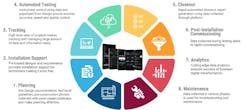Intelligent build solutions are key to the success of future network deployments
By Manja Thessin and Subbu Meiyappan
We currently find ourselves in a period of unprecedented demand for network infrastructure. The rapid adoption of digital technologies, such as artificial intelligence (AI), predictive analytics and the internet of things (IoT), have further heightened this trend. As the digitization and virtualization of business and society continues, more and more demands are placed on the data center because of the immense amount of potential it holds. For data center companies to realize this potential, they must operate more efficiently. To operate more efficiently, the industry must undergo a transformation—a digital transformation, that is.
No longer is funding the main constraint to deploying digital infrastructure. A constrained labor market, challenges in the supply chain, lack of real-time visibility into project execution, difficulty in auditing daily project results, lack of data integrity and more are all roadblocks to digitizing a network as each results in network inefficiencies and costs. It’s estimated that large-scale construction project delays more than doubled during the COVID-19 pandemic. According to data from nPlan, released in 2022, pre-pandemic projects were delayed by around 100 days, while pandemic-era projects had a median delay of more than 200 days. Plus, construction technology firm, Autodesk, and management consulting firm, FMI Corp., conducted a study on the high cost of bad data. In 2020, it was estimated that bad data in construction may have cost $1.84 trillion and caused 14% of all construction rework.
The traditional approach to infrastructure deployment management is no longer feasible. It’s crucial that technicians enable fast, consistent, and accurate deployment of networks to address these key infrastructure deployment challenges. Automation and data coordination are essential to efficiently deploying a network’s infrastructure as well as operating with the principle of build it right the first time.
Why, and how, to digitize a network build
Digitizing a network build offers many benefits, such as increasing productivity, reducing project costs and providing greater levels of visibility into project execution for project managers, customers and even for the general contractor. This allows everyone involved to have real-time visibility and access to the project, offsetting the efficiency impacts brought on by the ongoing challenges.
To maximize the efficiency of network deployment, a solution is needed to connect the individual silos of data. An ecosystem of tools is coming into existence that can be woven together into an optimized solution to address this, combining everything from manufacturing to network turn-up and activation. We denote this as an intelligent build solution.An intelligent build solution adds “intelligence” to a passive infrastructure by leveraging mobile technology to “digitize” the tools we can use in the field. It combines elements of construction digitization, Software-as-a-Service (SaaS), electronic identification and AI, digitizing the construction process. These concepts are part of the digital transformation reshaping all areas of business today, fundamentally changing how companies operate and deliver value to their customers. Such technologies help organizations compete in a digitally transformed world that will improve customer experience through real-time, data-driven transactions and uncover new opportunities for growth.
Housing a powerful workflow management suite, an end-to-end intelligent build solution augments traditional ICT business systems and operations. Acting as a digital journaling solution, it captures the life of a fiber-optic cable or passive optical component and follows it from cradle to grave—from the time it is made in the manufacturing plant, to its installation into a network, through subsequent moves or reconfigurations, until the end of its life when it is eventually decommissioned.
This journey begins with the scanning of a radio frequency identification (RFID) tag, or a barcode, that the manufacturer has placed on a cable or component. This generates a digital fingerprint that promptly crosslinks to manufacturer specification sheets, reference drawings, build and shipping details. It can also provide access to manufacturing test data, creating a vital link and transparency between the manufacturer, ICT installer and end customer. By tracking the span of a product from the moment it receives its RFID tag to its decommissioning, this cradle-to-grave solution allows technicians to monitor the lifecycle of building a network.
For example, this solution offers installation support by giving technicians access to pre-loaded designs, scope requirements and step-by-step work instructions. Such a solution provides assurance that the right work is occurring every step of the way. This additional layer of installation support and instant feedback has the potential to significantly reduce the risk of errors or omissions.
Visibility and management capabilities
Enabled with integrated project management capabilities, one also has the visibility to progress across all sites and scope elements. A project management dashboard provides visibility into a project via real-time data collection, eliminating the need to chase contractors and technicians for updates. Workflow tracking provides feedback on progress and performance of field splicing teams. In the event of scope changes, engineers or project managers can modify the task list and test plan remotely through a portal, which instantly updates the work instructions for technicians in the field.An intelligent build solution further allows for automated testing, which enables real-time instrument control using data prepopulated from the design source—ensuring accuracy, speed, and quality control. The testing application captures the raw data files and screen shots from the testing instrument, provides notes and photos all organized and instantly captured once the test is completed. Using machine learning, the app can recognize errors and spec deviations and offers live mitigation instructions. Testing and splicing events—some of the most time-consuming efforts of an ICT data center deployment project—are seamlessly uploaded to the project record. Instant and nightly summaries notify the team when testing or splicing activities have been completed and provide instant visibility to the test data.
Closing the deal
Additionally, an end-to-end solution enables a fast automated closeout report generation using data collected via the platform throughout the life of the project. Closeout reports including test and splice data, photos, punch list reports and completed task checklists are immediately compiled as the data is collected from the field. The project manager works through an approval workflow and generates highly customized reports using customer templates. The closeout package provides a dynamic view of the complete network end-to-end results.
Data centers have become the foundation of the digital economy and are critical to our ever-more-digitized way of life. For data centers to compete and operate efficiently, they must adopt digital transformation and embrace the concept of an intelligent build solution. Bringing together elements of intelligent passive infrastructure, the automation and digitization of test and splice equipment, intelligent build solutions can bring many benefits to end-customers, ICT installers, general contractors, and suppliers. The ability to scan, inventory, track, and organize materials based on a prebuilt workflow alone could avoid countless hours searching for the right materials to deploy.
A true cradle-to-grave solution enables greater efficiency and accuracy in build, improves overall productivity, and brings labor savings by addressing the challenges and inefficiencies commonly present in deploying optical networks. Now, more than ever, it is critical that a full end-to-end solution be embraced to enable modern ICT network deployments.
Manja Thessin RCDD/RTPM serves as enterprise market manager for AFL, leading strategic planning, and market analysis initiatives. Manja has more than 20 years of ICT experience in the field, design and engineering, and project management. She has managed complex initiatives in data center, education, industrial/manufacturing and healthcare. Manja earned a master’s certificate from Michigan State University in Strategic Leadership and holds RCDD and RTPM certifications with BICSI®.
Subbu Meiyappan is the founder and CEO of ECSite, Inc., a Silicon Valley SaaS company that strongly believes end-to-end automation is the key to successful digital infrastructure deployment at scale. Prior to ECSite, Subbu co-founded NextNav, an indoor location company. He has a strong background in RF, fiber and software. Subbu holds more than 30 US and International patents.

